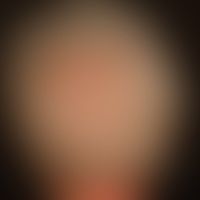Image diagnoses for "skin-colored", "Scalp (hairy)"
27 results with 68 images
Results forskin-coloredScalp (hairy)

Alopecia androgenetica in women L64.-
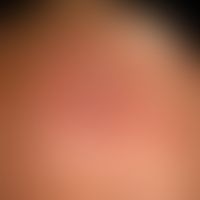
Extrinsic skin aging L98.8
Light aging of the skin: smooth atrophic skin with flat actinic keratosis (frontal area) with translucent vessels
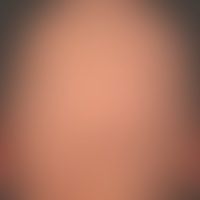
Alopecia areata (overview) L63.8
Alopecia areata (Grade 2-3): extensive loss of hair in the capillitium. at higher magnification, the preserved (hairless) follicles can be seen. preserved hair rings partly mark the grown alopecia foci. note individual re-grown pigment-free hairs

Alopecia androgenetica in men L64.-

Frontal fibrosing alopecia L66.8
alopecia postmenopausal, fibrosing, uniform receding of the frontal and temporal hairline. encircling a flat erythema originating from follicles. arrows: discrete perifollicular redness. distinct ulerythema ophryogenes with complete destruction of the eyebrows (square). keratosis follicularis on the extensor extremities.

Aplasia cutis congenita (overview) Q84.81

Folliculitis decalvans L66.2
Folliculitits decalvans: scarring alopecia with shiny hairless area and tufts of hair at the edges.

Alopecia androgenetica in women L64.-

Acne conglobata L70.1
Acne conglobata: symmetrically distributed, eminently chronic, inflammatory and melting papules and pustules as well as strong, retracted scar formation, with retention fluctuating in places.

Alopecia androgenetica in men L64.-
Alopecia androgenetica in men. stage IV: confluence of anterior and posterior hair thinning in the parietal region.
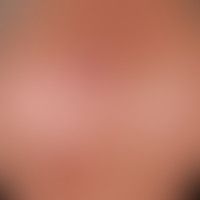
Carcinoma of the skin (overview) C44.L
Carcinoma kutanes (carcinoma in situ of the actinic keratosis type) 1a keratoses) with transition to an invasive spinocellular carcinoma (bottom left)

Alopecia androgenetica in men L64.-
Alopecia androgenetica in men. stage V: Almost complete hair loss with a narrow, thin ring of hair at the sides and back in a 50-year-old man.

Frontal fibrosing alopecia L66.8
Postmenopausal fibrosing frontal alopecia: For several years now, the hairline has been continuously moving backwards. Clear ulerythema ophryogenes. Complete hairlessness of arms and legs (condition after keratosis pilaris) which has not been noticed before.

Alopecia androgenetica in women L64.-

Alopecia marginalis L65.9
Alopecia marginalis: 45-year-old woman, who has been fixing the curly hair on the top of her head with 2 crossed hair clips for years. In the area of the hair clips now circumscribed hairless plaque with slight induration and coarsening of the skin surface. A histological examination was performed to exclude other causes.

Pachydermoperiosteosis, primary M89.4
pachydermoperiostosis, primary: A 32-year-old man of Han Chinese origin presented with a 15-year history of a peculiar facial appearance (Panel A). after puberty, he had noticed a progressive enlargement of his hands and feet as well as facial furrowing. the patient reported that the progression of disease had stabilized by the time he was 27 years of age. on examination, he had excessive sebaceous secretions and thick, furrowed, and redundant skin on his forehead, cheeks, and chinese. soft-tissue hypertrophy reduced the motion of his hands and feet, with terminal broadening of the fingers (Panel B) and toes and cylindrical enlargement of the limbs. the patient received a clinical diagnosis of pachydermoperiostosis, a rare genetic disease characterized by pachyderma, digital clubbing, and periostosis. his parents and son did not have similar symptoms; no genetic testing was performed. the therapy was performed in two stages. in the first stage, we implanted an expander under the patient's forehead skin to enlarg
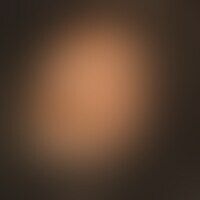
Aplasia cutis congenita (overview) Q84.81
Aplasia cutis congenita. 8.0 x 6.0 cm, yellowish-white alopecic focus with shiny surface, existing since birth, unchanged for years except for size increase during physical growth.

Alopecia areata (overview) L63.8
Alopecia areata: Beginningnew hair growth of a hairless area in an 8-year-old girl which has existed for a few months.





